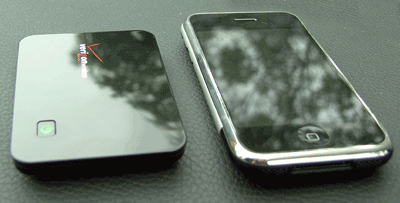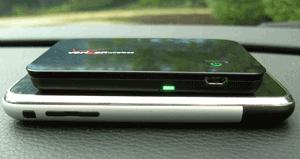The Verizon MiFi: A Wi-Fi Hotspot for Everywhere
It always seems like one needs Internet access when it is least available. That’s why many of us have bought iPhones and Blackberries in recent times. But, that still doesn’t solve the problem if one has a couple of computers and needs them to be connected – right here and right now, wherever the here may be. Or, for that matter, not just computers, but an iPod touch, a Nintendo DS or any other sort of Wi-Fi enabled device. If only every place was a Wi-Fi hotspot! With the MiFi, “here” finally is a hotspot.
 |
|
The MiFi (left) next to an original iPhone gives some idea of just how small this 3G to Wi-Fi router is. |
The MiFi is an ingenious little device that combines a 3G data modem with a wireless router – essentially bridging the gap between your numerous Wi-Fi enabled devices and cellular broadband. Manufactured by Novatel and released to the world on Verizon’s 3G network earlier this month, it is a sleek but unassuming looking little device.
The MiFi is approximately the width and length of your favorite credit card and the depth of an audio CD jewel case – it is hard to believe the device could really do very much in such a tiny form. In addition to a diminutive case, in a design straight out of Steve Jobs’ playbook from Apple, that case is adorned with just one button and two lights.
But, the Apple comparison need not end with the appearance. The device also has another quality that is essential to everything Apple sells: it just works. OFB tested the MiFi with a variety of wireless devices and found all of them worked well, connecting to the MiFi is as simple as connecting to any other secure wireless access point. (One can also put it into a non-secure mode, but amongst other reasons, bandwidth costs should argue strongly against that.)
Security is one thing that makes the MiFi attractive even when an area is blanketed in hotspots. This access point creates a WPA2 secured network for up to five devices wherever it is. Instead of necessity driving one to doing sensitive work on a totally public network, the MiFi offers the option of a secure, private network wherever you may be.
The simplicity of the MiFi is what makes it so remarkable. Almost immediately after hitting the power button, which turns bright green when the device is on, our Wi-Fi devices were ready to surf and relatively quickly at that. In most tests we performed throughout the Gateway City, we were able to get speeds of around 1.5 Mbps – better than many basic DSL connections fare in similar tests.
In a rather ironic turn of events, we even found Verizon’s MiFi helped AT&T’s iPhone. While we continue to find AT&T’s 2G network failing to provide consistent connections to first generation iPhones, with the MiFi on, the same iPhones that were unable to call out, much less surf the web in many places we tested were suddenly surfing as well as they do on a DSL-powered router. If not for the need to maintain multiple service plans to do it, the added life the MiFi provided to the iPhone would almost make it worth using the devices as a pair.
The MiFi’s reception was nothing less than spectacular in our testing. While the MiFi outperformed the iPhone’s 2G EDGE connection, it also performed well in areas where virtually any cell phone we have tested performed poorly. In preparing for this story OFB contacted AT&T to offer that company a chance to provide a comparably capable 3G device so we could a fairer network comparison, but the company had not responded by press time.
Verizon tells us that although the MiFi, like its other current devices, is not capable of communicating over the up-and-coming LTE network it plans to launch next year, the company is “committed to its CDMA network through the next decade.”
 |
|
The MiFi (top) and the first generation iPhone. |
On a rare occasion, the device stepped down to the slower EvDO Rev. 0 network, but, by and large, even in less populated parts around our testing area, the MiFi was able to pull in a Rev. A signal. Only in a few situations did its connection drop below 1 Mbps in download speed.
While we were only able to test the device for a short period of time, we did find that during the testing the battery performed remarkably well, easily lasting multiple hours without any trouble.
It’s hard to find anything not to like about this device, — but there is one thing and may be significant: service price. At $60/month for the plan with a 5GB quota, it is competitive with USB-based 3G cellular devices, while being potentially much more useful and certainly more flexible. Unfortunately, that price still makes it hard to justify for many who could find it useful but are not road warriors.
There is a smaller 250 MB plan for $40, but how easy and delightful the MiFi is to use, even the 5GB plan could feel constrained – opting for the 250 MB plan is just asking for overages. In the best case scenario, overage fees place the next gigabyte after the fifth one at a whopping $51 – almost as much as the first five – so users really need to be careful in an age of streaming media, especially with a device that makes downloading over cellular so painless. We would like to see a true, unlimited (or, at least, much larger) plan and significantly lower, more landline-like pricing, but this is a quibble with the cellular industry as a whole rather than the MiFi itself. The shame with the MiFi is that it could be easily commended as one’s primary Internet access device, if only a much larger quota were included.
In sum, though, our recommendation is this: if you ever venture away from known Wi-Fi hotspots and can justify the subscription price for your usage, buy a MiFi. In the same way the iPhone revolutionized web browsing from a phone, the MiFi is a game changer that makes cellular Internet a pleasure to use on almost any device (Novatel/Verizon Wireless, vzw.com; $149/$99 offline/online pricing with 2yr. commitment).
Timothy R. Butler is Editor-in-Chief of Open for Business.
Join the Conversation
Re: The Verizon MiFi: A Wi-Fi Hotspot for Everywhere
What a superb idea! While I do agree that the $60/month service price could be considered a con, if the service is as reliable as OFB says I would say it’s well worth it!
Re: The Verizon MiFi: A Wi-Fi Hotspot for Everywhere
I have a Samsung Omnia from Verizon. Installing VMWifiRouter or tethering software allows the phone to perform this same function. Therefore, it’s just a subset of current smart phone functionality.
Re: The Verizon MiFi: A Wi-Fi Hotspot for Everywhere
“if the service is as reliable as OFB says I would say it’s well worth it! ” Oh it is; I have an aircard (EVDO Rev 0), and on the most recent road trip from eastern Iowa to eastern Pennsylvania (950 miles) I was on EVDO for over 900 miles of it. The other ~50 miles, I didn’t lose service, it just dropped to 1X speeds. A few “low signal” EVDO spots speeds would drop to like 384kbps, but 800kbps+ generally. And keep in mind that’s with a Rev0 aircard; the mifi’s surely got a much bigger antenna, and is RevA, so it’d be even better. Having a wifi bubble, if you’re on a road trip with people with laptops, PDAs, etc., would be a great use for a mifi (keeping in mind the 5GB cap.)